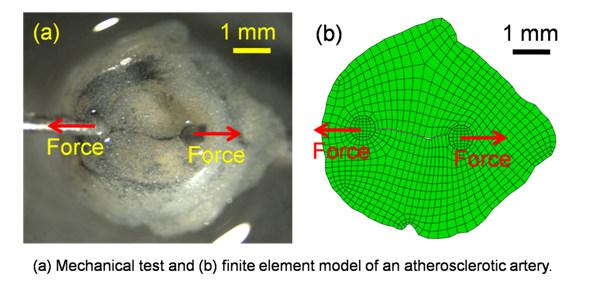
The Engineering for Clinical Practice initiative brings together engineers and clinicians with the aim of improving clinical tools by the application of engineering research, techniques and innovation to the field of clinical medicine.
Engineering for Clinical Practice (ECP) grants are intended to encourage such research, particularly where it represents a new direction which is at too early a stage to attract major funding but might have potential to do so at a later date. Two grants have recently been awarded. One was awarded to Chen Yen Ooi and Dr. Michael Sutcliffe (Department of Engineering), Dr. Anthony Davenport (Clinical Pharmacology Unit) for research into the Biomechanics of Atherosclerotic Plaque. The second was awarded to Gergely Zsigmond Racz, Prof. Richard Penty and Dr. Nikos Bamiedakis (Department of Engineering), Mr. Peter Hutchinson and Dr. Keri Carpenter (Department of Clinical Neurosciences) for research into Optical Sensors for Online Brain Microdialysates Analysis.
Below is a summary of the projects.
Biomechanics of Atherosclerotic Plaque
Cardiovascular disease is a major cause of death, with particular concern for atherosclerosis which leads to stroke or heart attack. In this project, the biomechanical response of atherosclerotic arteries to pharmacological drugs and mechanical loading is examined. Both mechanical testing and finite element modelling is performed to obtain the mechanical properties of the diseased arteries. This study is expected to lead to more effective ways for medical clinicians to identify vulnerable atherosclerotic tissue and novel drug treatments, thus preventing subsequent diseases.
Optical Sensors for Online Brain Microdialysates Analysis
Head injury is the leading cause of death in the under-40y population in the developed world. While some individuals have good outcomes, others experience varying degrees of disability, which are often life-long, with consequent demands on carers and resources. Following the initial impact, a complex series of biochemical and biological changes occurs in the hours and days that follow and are potentially amenable to intervention. Brain chemistry, including energy-related molecules, can be monitored by inserting fine semi-permeable tubes into the brain, a technique called microdialysis. A well-recognised characteristic of adverse metabolism is a microdialysate lactate-to-pyruvate ratio of above 25, which is associated with poor outcome. Brain microdialysates are inherently very small volume samples (typically 18 µL/h), and are technologically demanding to analyse. Glucose, lactate and pyruvate are measured at the bedside using commercially available analyzers, but because of these instruments’ technical limitations, they have a slow response time.
The goal of the proposed project is to enable pilot work on the development of an optical sensor for the continuous real-time measurement of glucose, lactate and pyruvate concentrations in brain microdialysates from head injury patients in the Neurosciences Critical Care Unit (NCCU) at Addenbrooke's Hospital using polymer waveguide technology developed by the Photonic Systems group in the Engineering Department. The work aims at carrying out initial investigations on the potential of developing low-cost bio-medical polymeric optical sensors suitable for use in clinical environments and generating early-stage results to attract further funding towards this goal.
Further information on applying for these grants can be found here

